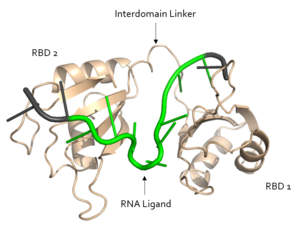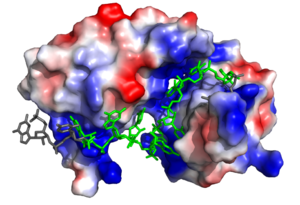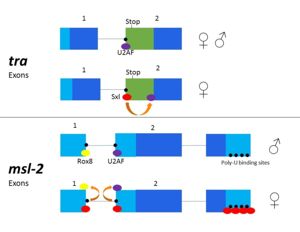User:Kyle Burton/Sandbox1
From Proteopedia
(Difference between revisions)
| Line 33: | Line 33: | ||
== Alternative Splicing Pathways == | == Alternative Splicing Pathways == | ||
[[Image:Sxl_altsplicing_mechanism_figure_version4.jpg|300px|left|thumb| '''Figure 3.''' 2-dimensional representation of alternative splicing repression by Sxl on the ''tra'' and ''msl-2'' genes.]] | [[Image:Sxl_altsplicing_mechanism_figure_version4.jpg|300px|left|thumb| '''Figure 3.''' 2-dimensional representation of alternative splicing repression by Sxl on the ''tra'' and ''msl-2'' genes.]] | ||
| - | The alternative splicing pathways of Sxl differ, but both involve repression at the 3' splice site<ref name="Handa"/><ref name="Black"/>. The ''tra'' expression pathway only involves the 3' splice site, while the ''msl-2'' pathway involves both the 3' and 5' splice sites. Both mechanisms cause U2AF binding downstream with lower affinity (Fig. 3)<ref name="Black"/>. U2AF is a more general splicing factor than Sxl, and prefers cytidine-containing poly-uridine pre-mRNA sequences, so Sxl binds to the guanosine-containing pre-mRNA with a 10<sup>4</sup>-fold greater affinity<ref name="Handa"/>. | + | The alternative splicing pathways of Sxl differ, but both involve repression at the 3' splice site<ref name="Handa"/><ref name="Black"/>. The ''tra'' expression pathway only involves the 3' splice site, while the ''msl-2'' pathway involves both the 3' and 5' splice sites<ref name="Bashaw"/>. Both mechanisms cause U2AF binding downstream with lower affinity (Fig. 3)<ref name="Black"/>. U2AF is a more general splicing factor than Sxl, and prefers cytidine-containing poly-uridine pre-mRNA sequences, so Sxl binds to the guanosine-containing pre-mRNA with a 10<sup>4</sup>-fold greater affinity<ref name="Handa"/>. |
=== Autoregulation === | === Autoregulation === | ||
| Line 43: | Line 43: | ||
=== ''Msl-2'' === | === ''Msl-2'' === | ||
| - | Msl-2 is responsible for [https://en.wikipedia.org/wiki/Dosage_compensation dosage compensation] of X chromosomes in fruit flies. The alternative splicing of ''msl-2'' is reliant on Sxl binding to both the 5' and 3' splice sites (Fig. 3). Sxl binds at the 3' splice site, replacing U2AF as in ''tra'' splicing. Sxl also competes with [http://www.uniprot.org/uniprot/Q26281 Rox8], which binds to the first intron. As a result, Sxl prevents splicing of the first intron of the ''msl-2'' primary transcript<ref name="Georgiev"/>. Sxl also binds to the poly- U sequences of the 3' UTR to repress translation (Fig.3)<ref name="Penalva"/>, leading to female expression. When Sxl targets ''msl-2'', the first intron is retained<ref name="Black"/><ref name="Georgiev"/>. However, the retained intron is in the [https://en.wikipedia.org/wiki/Untranslated_region 5' UTR] and does not affect the reading frame<ref name="Black"/>. When ''msl-2'' is expressed, the X chromosome's transcription is repressed. In male fruit flies, ''msl-2'' must be inactivated to allow increased X chromosome transcription<ref name="Georgiev"/>. As the expression of ''msl-2'' is exclusively required for male fruit fly development, any mutation in Sxl protein which causes splicing and activation of the ''msl-2'' gene in females leads to female fly death by hyperexpression of both X chromosomes<ref name="Georgiev"/>. | + | Msl-2 is responsible for [https://en.wikipedia.org/wiki/Dosage_compensation dosage compensation] of X chromosomes in fruit flies<ref name="Bashaw"/>. The alternative splicing of ''msl-2'' is reliant on Sxl binding to both the 5' and 3' splice sites (Fig. 3). Sxl binds at the 3' splice site, replacing U2AF as in ''tra'' splicing. Sxl also competes with [http://www.uniprot.org/uniprot/Q26281 Rox8], which binds to the first intron. As a result, Sxl prevents splicing of the first intron of the ''msl-2'' primary transcript<ref name="Georgiev"/>. Sxl also binds to the poly- U sequences of the 3' UTR to repress translation (Fig.3)<ref name="Penalva"/>, leading to female expression. When Sxl targets ''msl-2'', the first intron is retained<ref name="Black"/><ref name="Georgiev"/>. However, the retained intron is in the [https://en.wikipedia.org/wiki/Untranslated_region 5' UTR] and does not affect the reading frame<ref name="Black"/>. When ''msl-2'' is expressed, the X chromosome's transcription is repressed. In male fruit flies, ''msl-2'' must be inactivated to allow increased X chromosome transcription<ref name="Georgiev"/>. As the expression of ''msl-2'' is exclusively required for male fruit fly development, any mutation in Sxl protein which causes splicing and activation of the ''msl-2'' gene in females leads to female fly death by hyperexpression of both X chromosomes<ref name="Georgiev"/>. |
== Relevance == | == Relevance == | ||
Revision as of 17:25, 20 April 2018
| |||||||||||
References
- ↑ 1.00 1.01 1.02 1.03 1.04 1.05 1.06 1.07 1.08 1.09 1.10 1.11 1.12 1.13 1.14 1.15 1.16 1.17 1.18 1.19 1.20 1.21 1.22 1.23 Handa N, Nureki O, Kurimoto K, Kim I, Sakamoto H, Shimura Y, Muto Y, Yokoyama S. Structural basis for recognition of the tra mRNA precursor by the Sex-lethal protein. Nature. 1999 Apr 15;398(6728):579-85. PMID:10217141 doi:10.1038/19242
- ↑ 2.0 2.1 2.2 2.3 Penalva L, Sanchez L. RNA Binding Protein Sex-Lethal (Sxl) and Control of Drosophila Sex Determination and Dosage Compensation. Microbiol Mol Biol Rev.;67(3):343-356. doi: 10.1128/MMBR.67.3.343–359.2003
- ↑ 3.0 3.1 3.2 Bashaw GJ, Baker BS. The msl-2 dosage compensation gene of Drosophila encodes a putative DNA-binding protein whose expression is sex specifically regulated by Sex-lethal. Development. 1995 Oct;121(10):3245-58. PMID:7588059
- ↑ 4.00 4.01 4.02 4.03 4.04 4.05 4.06 4.07 4.08 4.09 4.10 4.11 4.12 4.13 Black DL. Mechanisms of alternative pre-messenger RNA splicing. Annu Rev Biochem. 2003;72:291-336. doi: 10.1146/annurev.biochem.72.121801.161720., Epub 2003 Feb 27. PMID:12626338 doi:http://dx.doi.org/10.1146/annurev.biochem.72.121801.161720
- ↑ 5.0 5.1 5.2 5.3 5.4 Georgiev P, Chlamydas S, Akhtar A. Drosophila dosage compensation: males are from Mars, females are from Venus. Fly (Austin). 2011 Apr-Jun;5(2):147-54. Epub 2011 Apr 1. PMID:21339706



